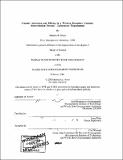Chaotic advection and mixing in a western boundary current-recirculation system : laboratory experiments
Author(s)
Deese, Heather E. (Heather Elizabeth), 1975-
DownloadFull printable version (12.86Mb)
Other Contributors
Woods Hole Oceanographic Institution.
Advisor
Larry Pratt.
Terms of use
Metadata
Show full item recordAbstract
I study the exchange between a boundary current and flanking horizontal recirculations in a 'sliced-cylinder' rotating tank laboratory experiment. Two flow configurations are investigated: a single recirculation and a double, figure-8, recirculation. The latter case involves a hyperbolic point, while the former does not. I investigate the stirring and mixing under both steady and unsteady forcing. I quantify the mixing in each case using effective diffusivity, Keff, and a corollary effective length, Leff, as derived by Nakamura (1995, 1996). This approach involves diagnosing the geometric complexity of a tracer field. Geometric complexity is indicative of advective stirring. Because stirring creates high gradients, flows with high advective stirring also have high diffusion, and stronger overall mixing. I calculate effective length from images of dye in the tank and find much higher values of Leff in the unsteady hyperbolic cases than in the other cases. Slight unsteadiness in flows involving hyperbolic points gives rise to a chaotic advection mechanism known as 'lobe dynamics'. These lobes carry fluid in and out of the recirculations, acting as extremely effective stirring mechanisms. I demonstrate the existence of these exchange lobes in the unsteady hyperbolic (figure-8) flow. The velocity field in the tank is calculated utilizing particle image velocimetry (PIV) techniques and a time series U(t) demonstrates the (forced) unsteadiness in the flow. Images of dye in the tank show exchange lobes forming at this same forcing period, and carrying fluid in and out of the recirculation. Based on the results of these experiments, I am able to confirm that, at least in this controlled environment, basic geometry has a profound effect on the mixing effectiveness of a recirculation. I demonstrate radically increased stirring and mixing in the unsteady hyperbolic flow as compared to steady flows and flows without hyperbolic points. Recirculations are ubiquitous in the world ocean; they occur on a variety of scales, in many different configurations, and at all depths. Some of these configurations involve hyperbolic points, while others do not. Chaotic advection via lobe exchange may be an important component of the mixing at multiple locations in the ocean where hyperbolic recirculation geometries exist.
Description
Thesis (S.M.)--Joint Program in Oceanography (Massachusetts Institute of Technology, Dept. of Earth, Atmospheric, and Planetary Sciences; and the Woods Hole Oceanographic Institution), February 2001. Includes bibliographical references (p. 116-118).
Date issued
2001Department
Joint Program in Oceanography; Woods Hole Oceanographic Institution; Massachusetts Institute of Technology. Department of Ocean EngineeringPublisher
Massachusetts Institute of Technology
Keywords
Joint Program in Oceanography., Earth, Atmospheric, and Planetary Sciences., Woods Hole Oceanographic Institution.